Early Summer 2014


Continuing our exploration of the Midlands countryside we visited Boscabel House which is an English Heritage property that became famous for being the first hiding place of Charles II after his defeat in the English civil war at Worcester in 1651.
Charles viewed the defeat of his army from the tower of Worcester Cathedral and escaped with several hundred men pursued by Cromwell's soldiers intending to cross the Severn and then to Swansea to find a ship and return to France. He found his escape to 'Whales' (Charles spelling as we know they are actually bloody great fishes!) blocked so turned inland and after two days in the open in pouring rain it was decided to make for Boscabel House, owned by one of his Royalist officers, Charles Giffard of Chillington.
Charles arrived at Boscabel to be told that it was not safe to stay in the house so he and his companion, Major William Careless, spent 18 hours in an oak tree situated in the surrounding forest while Cromwell's troops searched for them in the forest below. A descendant of the original tree still stands though much damaged by tourists over the years removing souvenirs and lightening strikes. A daughter tree stands beside the old tree which was grown from one of it's acorns. The Royal Oak, as it became known, is still one of the most popular pub names.
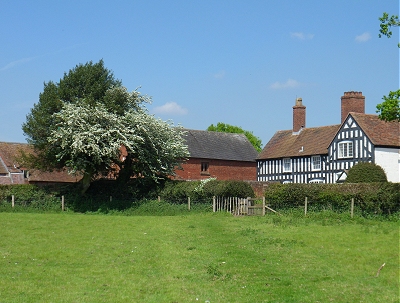
Boscabel House began life as a hunting lodge which was gradually extended and eventually became a farmhouse with stables and barns. Charles only stayed a few nights before moving on to Moseley Old Hall which we visited earlier this year and where you can read a further account of Charles's exploits. The people who sheltered and assisted him in his escape would have faced certain execution had they been found and after the restoration in 1660 the king awarded many of them a life pension in perpetuity which is still administered to their descendants to this day.
Charles II was the last of the Stuart's as he had no heirs with Catherine of Braganza, however, he had quite a collection of mistresses, the most famous being Barbara Palmer, 1st Dutchess of Cleveland, with whom he had five children. The late Diana, Princess of Wales was a direct descendant of one of Charles II children, Henry Fitzroy, which means that if and when Diana's son, Prince William, ascends to the throne we will once again have a king who is a descendant of the House of Stuart.
We visited Belgium again where the good weather allowed us to turn Harmonie and completely paint the Port side which resulted in the usual blisters and sore joints!
We paid the electricity bill for the six winter months. It was only 150 Euroles as we were only on board for a few weeks during the period but the new central heating circulating pump was running all the time and I reckon has paid for itself already. Last winter was really mild and it was rarely below freezing so we used hardly any heating oil.
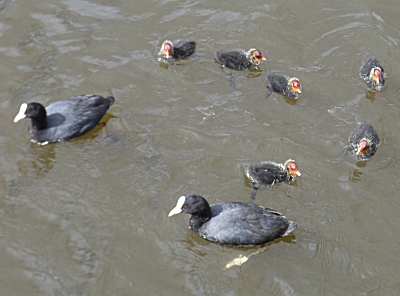
Our tame yacht club joiner, Jean-Walter, did a great job repairing the wheelhouse ceiling and charged us a reasonable amount for his services so we were really pleased.
Mrs Coot on the opposite bank had given birth to six chicks and she and Mr Coot entertained us with daily diving instruction classes.
The Harris's were in residence on their barge Ebenhaezer who provided dinner for us on arrival and led us astray on numerous occasions drinking much too much booze.
The week ended with them setting off for Harlingen for a few days and us driving back from Dover in pouring rain until we arrived back at Bridgnorth where the sun had been shining all day.
| CLICK HERE FOR MY EU RANT! |
We had a weekend in London which had been planned for some time to watch the Aviva premiership final between Northampton and Saracens on the Saturday followed by the Barbarians v an England XV on the Sunday. We booked the Sheraton Heathrow Hotel as it is only about 8 miles from Twickenham Stadium, the price seemed attractive (for London) at £170 B&B for two nights stay and we could travel to and from the ground by bus using our free bus passes.
We arrived in good time and checked in to the hotel, discovered the bus stop to Hounslow nearby but soon found ourselves in a huge traffic jam. It took over an hour to get to Hounslow, a trip which should have taken 20 minutes but found the bus to Twickers and arrived at the ground in good time for an exciting game. The teams were tied at the end of normal time so played extra time 10 minutes each way. In the final seconds Sarries were 3 points ahead and looked like winning until Saints scored a controversial try which was referred to the TMO who gave it. There was no way he could see for sure that the ball was over the line and so should not have given the try so poor old Sarries, having finished at the top of the premiership, ended the season with nothing to show for it having also lost the Heinekin Cup final the previous week.
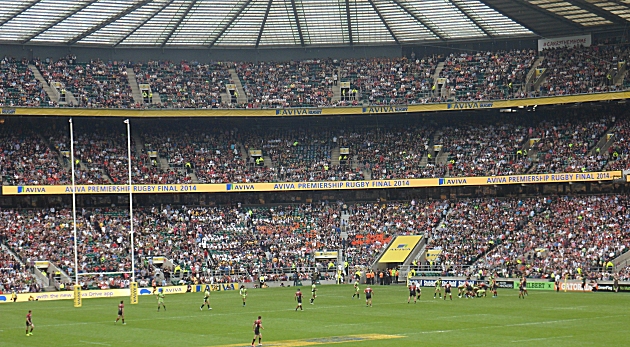
As the game had run over the allotted time and the bus back to Hounslow was diverted which involved a long walk, we decided to walk the 1.5 miles to save time. Back on the bus from Hounslow to the hotel we had thought the traffic would have calmed but if anything it was worse and I again wondered what possessed people to live in this god forsaken city which is dirty, full of foreigners and gridlocked with too many cars on an inadequate road system. We cancelled our reservation with a highly recommended Polish restaurant in town as there was no way we could then get there before they closed and found a very nice Indian restaurant close to the hotel.
The next day being Sunday the traffic had eased so we caught the bus to Hounslow West tube and travelled into town to the National Portrait Gallery where there was a fine exhibition to commemorate WW1. We also wandered around some of the rest of the gallery before walking up to Oxford Circus where I left Sue to the delights of the Oxford Street shops and took the tube to Richmond, walking on to Twickers for the England v Baa Baas game.
Not the exciting game that this fixture usually produces with lots of tries and spoilt by a poor French ref who needed glasses with Welsh touch judges and a TMO who should also have gone to Specsavers! Hosea Gear the AB's former winger scored two tries which was the difference between the two teams but this was really a Saxons team as the senior team is bound for New Zealand. The senior team are probably in for a hiding by the AB's as they are very much depleted of first choice players due to injuries and the players from the AP final not being available for the first test.

Whereas the ground was full with over 81,000 for the Aviva final the Baa Baas game only managed 50,000 so atmosphere was lacking.
Back at Richmond Sue had managed to negotiate tube closures to get there and we enjoyed a drink at a riverside pub. London prices determined it was only one drink before we found a Strada for a pizza and subsequently found our way back to our Heathrow hotel.
The next day we set off back up the M40 before diverting at High Wycombe to try and find a Waitrose supermarket. Having failed to find one we set Daphne SatNav to 'Scenic' and continued through the Chilterns into Oxfordshire where we discovered Thame and a Waitrose. On into Warwickshire and over Edge Hill to Stratford-on-Avon where Prince Charles gave us a wave and on into Worcestershire until we encountered a huge traffic jam just south of Kiddlyminster which I diverted over to Stourbridge to avoid.
I was born in Castle Bromwich, Warwickshire, just outside Birmingham and remember cycling over to Kenilworth as a kid. I also remember coming over the handlebars and landing on my head at Stonebridge on the way back! This would have been about 1947 and Kenilworth Castle was a stark ruin which was not open to the public. It was given to the town by Lord Kenilworth in 1958 and is now managed by English Heritage so I was now able to explore this imposing structure.

The castle was first built in the 1120's by the then royal chamberlain Geoffrey de Clinton who constructed the huge Norman Keep but it was King John who, in the 13th century, turned it into a formidable fortress by building a dam across the valley creating a huge lake on one side and forming a moat on the other together with extensive outer walls.
The son of Edward III, John of Gaunt, built the great hall with apartments and it became a favoured residence of the Lancastrian kings who were drawn by the excellent hunting in the surrounding forests. The lake not only provided protection but also fish and water fowl for the castle kitchens and King Henry V built a lodge at the far end of the lake which was used for banquets. But it was Robert Dudley, earl of Leicester, who was the favourite of Elizabeth I who gave him the castle and who converted it into a great palace for her entertainment in 1575.
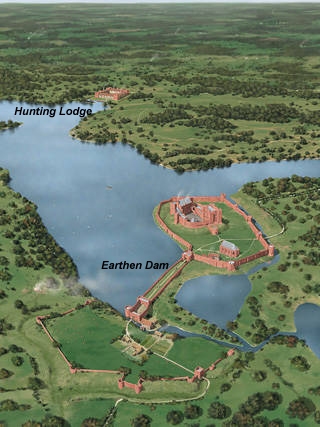

The illustration above left shows how the castle might have looked in about 1420 before Dudley built his royal apartments, his gatehouse and laid out the garden. You can see how the castle became encircled by water and the lodge at the top end of the lake. The adjacent picture on the above right shows the castle after Dudley had finished his building work.
It became one of the places that Cromwell knocked about a bit in 1650 when parliament declared it should be rendered incapable of being used as a fortress after the civil war so many of the defensive towers and walls were demolished, the lake drained and all the roofs removed so that much of the remaining buildings fell into a state of disrepair with the exception of the gatehouse which was converted into a private dwelling.
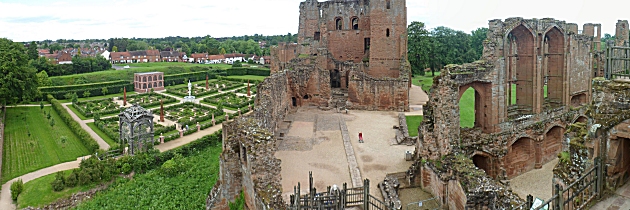
English Heritage reconstructed the Elizabethan garden from detailed records of the time and are in the process of restoring the royal apartments, built by Dudley to entertain the queen, due for completion sometime this year. Robert was hoping to induce the queen to marry him which was a difficult task, not the least being that he was already married and when his wife died mysteriously sometime later eyebrows were raised! Robert Dudley's Father,

The photograph above shows a bear chained to a ragged staff and is the heraldic sign of Richard Nevil, earl of Warwick (1428 - 1471). It is also in the coat of arms of Warwickshire and Shakespeare makes reference to it in his Henry IV, Part two.
Our England Rugby team, much depleted by injuries and players who could not be selected due to the Premiership final, played the All Blacks at Eden Park in Auckland. It was tied at 15 all in the last minutes of the game when, with England down to 14 men, that little Manatu Midget, Aaron Cruden created a try from a tap penalty and caught England off guard when everyone expected a place kick at goal. So England lost 20 - 15 to a side who haven't lost here for 20 years but did not play well against an England side with some key players who were fourth or fifth choices but who played out of their skins and were worthy opponents.
The next test is in Dunedin when England should be closer to their full strength. Expect at least seven team changes and the AB's to be much better but Englands depth of talent is encouraging 18 months out from the home world cup.
 David Austin Roses are a famous family business located in Albrighton in Shropshire. They propagate and sell roses of course to make money but they also have a beautiful 2 acre rose garden which is free to enter and June is the best time to see it.
David Austin Roses are a famous family business located in Albrighton in Shropshire. They propagate and sell roses of course to make money but they also have a beautiful 2 acre rose garden which is free to enter and June is the best time to see it.
Unfortunately on our first visit we chose the day of the Cosford Air Show when every farmer for miles around charged £10 to park in his field and the Rose Garden, which is adjacent to RAF Cosford, was charging £15 which you could offset against purchases. As we did not know what, if anything, we might buy we had to turn round and visit later in the week but we were caught in the air show traffic which was stationary for 10 miles almost back to Wolverhampton.

When we eventually visited a peacock screeched a greeting, showing off his finery and the roses were truly the finest we had ever seen anywhere.

There are over 700 varieties in the garden which also has the National Collection of English Roses.
One of the main competitors of David Austin is the French company Meilland International whose founder, the horticulturist Francis Meiland, developed the most successful of all hybrid tea roses of which hundreds of millions have been sold since it was introduced in the late 1930's. Francis first named it after his mother 'Madame A. Meilland' but after the war he wrote to Field Marshal Alan Brooke to thank him for his part in the liberation of France and asked him if he would give his name to the rose. Brooke declined suggesting instead that he named it 'Peace' which was publicly given the name in 1945.
It was also my fathers favourite rose so we bought a plant for our garden. The photo above was taken some weeks later when the plant we had bought first flowered.
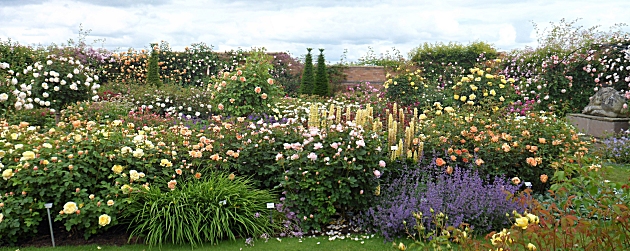
We are slowly ticking off the nearest National Trust properties and set off one morning for Berrington Hall just over the border in Herefordshire between Ludlow and Leominster.

We went via Cleobury Mortimer, home of our local Hobsons Brewery, as we had not explored the town before. There turned out not very much to explore apart from an interesting church with a leaning spire but a pleasant enough little town. Most towns claim some distinction and Cleobury's is that it is the smallest town in Shropshire.
Elizabeth I gave it to her best mate Robert Dudley; yes, the same Robert Dudley who she gave Kenilworth Castle to! He set up an Ironworks here and the town briefly became part of the birth of the industrial revolution before reverting back to an agricultural and brewing centre of course which it remains.
We passed a field of hops when we resumed our drive to Berrington through beautiful rolling wooded countryside. The hall was designed by Henry Holland in 1778-81 for Thomas Harley, a prominent politician of the time and the Lord Mayor of London. Holland was the son-in-law of Lancelot Brown otherwise known as Capability Brown who was a famous landscape architect responsible for the design of over 170 gardens for the landed gentry so it was no surprise to learn that Brown did the back yard!
Harley's daughter Anne married George, the son of Admiral Lord Rodney (a local bloke from Rodney Stoke!) who inherited the Estate and there are some fine paintings in the house of the great naval commanders battles. Unfortunately the 7th Lord Rodney gambled away the family fortune and had to sell the house in 1901 to a 'filthy' industrialist from Manchester, one Frederic Crawley MP whose son gave it to the National Trust in part payment of death duties.
The hall is in almost perfect condition with a classic Georgian interior design thanks partly to the care and sympathetic restoration work by the Crawleys.

It houses the Charles Paget Wade Costume Collection which contains over 2200 costumes from the 18th century to the Victorian period. Wade owned Snowshill Manor in the Cotswolds but lived in an adjacent cottage as his collection filled the manor house. He donated everything to the National Trust and his costume collection is housed at Berrington Hall where different exhibits are displayed throughout the year.
On our visit an exhibition of costume from the film The Duchess was being featured.
We took afternoon tea in the courtyard, as one does, and wandered round the walled garden before driving on to Ludlow, a town that reinvented itself as the 'foodie' capital of the region and it's claim to fame is that it is the largest town in Shropshire so we did the largest and smallest the same day! It also has some splendid old half timbered buildings, notably among them the Tudor Feathers Hotel, one of over 500 listed buildings.

Ludlow Castle is the venue of a Shakespeare and Arts Festival, A Food Festival and a Medieval Christmas Fayre so I am sure we will be back for one of those events in the future but on this occasion we were looking for a deli to buy a picnic for the Bridgnorth Proms in the Park the next day. We found one of course and bought a selection of goodies for the big event featuring the Bridgnorth Ukulele Band. No expense spared at the Bridgnorth Proms!
It was in Ludlow that Catherine of Aragon spent her wedding night with Prince Arthur which she claimed was never consummated when she later married Henry VIII after Arthurs death. Her divorce from Henry led to the reformation when Henry claimed his marriage to Catherine was illegal as he should not have married his brothers ex wife when we all know he just wanted an excuse to get a leg over Anne Bolyn!
Horatio Nelson had a bit of how's your father with Emma, his mistress, in the Angel Inn, when she stayed there with her Husband!
On the foodie front the town has two Michelin starred restaurants and numerous others, three butchers and lots of local food producers who show off their wares at the annual food festival. You can visit the Ludlow Brewing Company who, like Hobsons, use local hops and the town also has a regular Farmers market so we are bound to be back for both of those!
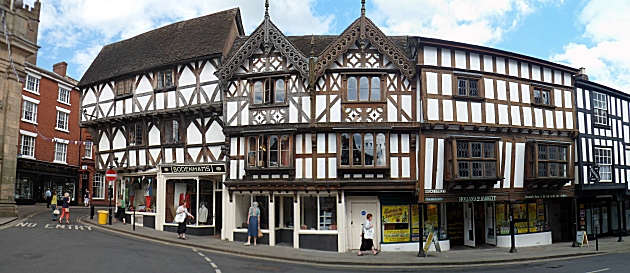
The weather turned to rain the next day so our picnic was eaten indoors and we can not report on the Proms in the Park. It stayed cold and wet the next day so the British traditional summer had returned.
The cold snap continued as we set off for a couple of days with our friends the Harpers in a holiday cottage they had rented in Solva, a little village close to St Davids in Pembrokeshire. We set the satnav to take us the pretty way, 180 miles across the middle of Wales and the further west we went the sun began to shine.
At Llandielo we stopped for coffee at the Angel Inn and bloody good coffee it was too. We complimented the barman on the coffee and he gave us a leaflet for his supplier, Coaltown Coffee, who only supply coffee to hotels and restaurants at the moment so I have suggested that they list all their outlets on their web site so we don't have to travel so far in future!
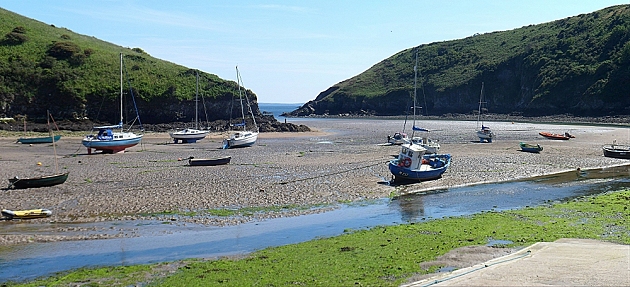
On arrival at Solva it was wall to wall sunshine and had been all week which makes a nonsense of Rhod Gilbert, the Welsh comedian, who claims that it always rains in Wales. Les and I spent a pleasant afternoon in the company of the Reverend James which you may think surprising until you learn that it is one of Brains beers and very good it was too!
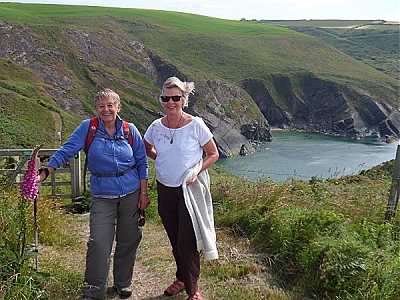
The evening was not so clever as we entered the Ship Inn's quiz night as the Bargees. They were almost a hour late starting and the landlord insisted on playing poor taste music so loud between questions we could not think properly. Sal complained but was told that if it was played quietly the quiz would be boring? The loud music was our excuse for only scoring 20 points when the winners scored thirty who must have liked the music or were wearing ear muffs!
Les dropped Sal, Sue and me off along the coast and we walked back to Solva along the coastal path. The scenery is much like the coastal path in Cornwall but with many more small islands offshore. In addition to the many walkers we also met some friendly pony's and a yachtsman who had anchored , swum ashore, fought his way 200 feet up a steep slope through gorse and brambles to emerge on the path, just to go for a jog!

Les was back with the Reverend James in the Harbour Inn at Solva so we joined him in quiet contemplation and shared a couple of pints of prawn's then it was off to the big bad city of St Davids. We had been there before but enjoyed wandering around the many shops and the Italian ice cream was authentic.
Back at the cottage we needed a sleep before setting out for the Cambrian Inn to join many other sensible folk who were avoiding watching England getting beaten in the Football World Cup. This was our hosts third visit and Les had not been able to get passed the Steak and Stilton pie on the menu. As this was our last night in Solva I followed his advice and joined him in appreciating the chefs masterpiece for his third time which came with a suet crust covering a strongly Stilton flavoured steak and kidney with a rich gravy to dip your chips into. Delicious.

The cottage had to be vacated by 10am but we were all off and away before 9am. We renewed our acquaintance with Narberth, about 23 miles away and had a full English or perhaps more accurately a full Welsh breakfast at the little cafe in the centre before buying Beaufort cheese, Spanish Coppa and Serrano at the splendid deli UltraCommida. Years ago as a member of the management committee of the Fine Food Association, I helped to judge a food competition for the Welsh Development Agency and we gave UltraCommida the top prize. I suspect it would win again as would Andrew Rees the butcher where we bought Rib Eye Steaks to take home. As we were travelling down to Somerset and the inevitable BBQ we also took advantage of his offer of 10 big thick Burgers for £7.99 and a dozen Narberth Sausages.

Arriving in Petherton on a Friday we gravitated to the Brewers Arms and not having seen many of the regulars for some months we did indulge rather. Back at the Hockeys this was continued over supper so that I was rather liverish the next morning and had to refuse any alcohol with my Full English in the Brewers while watching the England Rugby team emulate the England Football team and get soundly beaten by the AB's. The first half made me think they might have been drinking out of a damp glass the previous night like me but they won the second half playing catch-up Rugby. Only problem was that they didn't catch up!
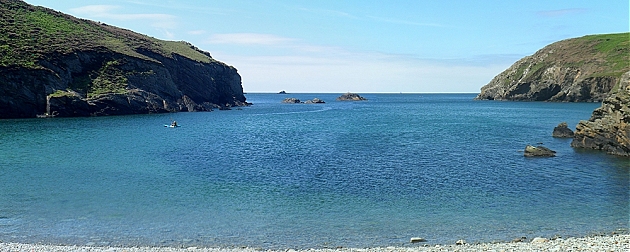
The folk festival was in full swing but I was in no mood for Morris dancing and had an alcohol free day sitting in the Hockeys back garden in the shade and admiring Chris's ditch of dreams! A "field of dreams" planted with wild flowers has become an annual event in the village which raises money for charity so Chris planted flowers in the field behind his back fence and calls it his ditch of dreams!
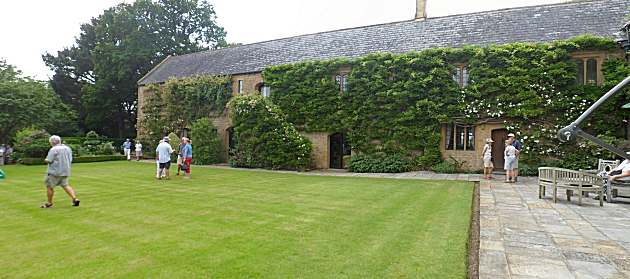
I had recovered the next day and we all walked over to East Lambrook Manor where Sir Geoff Mulcahy had his garden open to the public. He told us that an otter had eaten all his prize carp, one of which was valued at £5000! The local ladies provided tea and cakes which resuscitated us for the walk back which was quicker than the way we came due to Hockeys poor navigation. A pint of Thatchers cider was still needed in the Brewers on the way back which was the first time either of us had been the only customers in the bar!
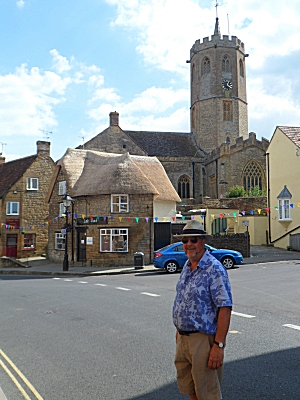
Little Thatch was resplendent with a brand new thatch and the Hockey's son Chrissy was the thatcher so Chris posed outside!
The BBQ that evening was one of the tastiest I have ever eaten with steak, snags and burgers from everywhere quite exceptional with the one exception of Jeremy's minted lamb which was just a big lump of gristle, much like Jeremy himself! No doubt that here in Britain we have some of the best butchers who have perfected their trade. On the continent the beef is bred for quantity not quality, killed too young, not hung for long enough and as a result is flavourless. Supermarket meat here also suffers from the same problems.
On the way home we diverted to Yarley to visit the Palmers before taking the pretty way back through Bradford on Avon and over the Cotswolds. The next day saw us paying our first ever visit to Merry Hill which is, or used to be, the biggest shopping centre in the Midlands. It has the benefit of being situated at Brierly Hill, just around the corner to the Vine Inn, known locally as the Bull and Bladder pub which is the home of Bathams Brewery and a spiritual place of pilgrimage for the beer lover! Just noted for any future visits and not patronised on this occasion!
We also visited Ashcroft Nurseries on the advice of Anne Clifford and spent even more money.
We had planned a trip to Berlin and Dresden in September but then found that our New Zealand friends Terri and Byron were in Prague for a few days that month so cancelled Germany and subbed the Czech Republic. Unable to book the same hotel but only a few streets away from them in the old city and an easy walk to all the sights. I remember when we lived in Edinburgh, the Norwegian Consul General telling me that Edinburgh reminded him of Prague, where he held a similar position, so we are both looking forward to our first visit there.
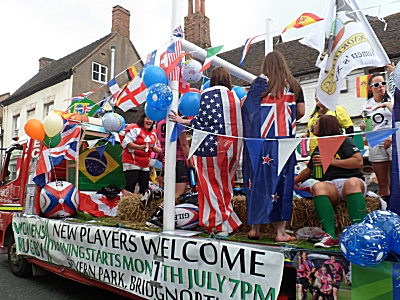
Bridgnorth has a carnival which passed by our house the other day. It was nothing like the big Guy Fawkes carnivals in Somerset which we are used to but it was good to see the locals advertising their interests, especially the Bridgnorth Women's Rugby Team. It used to be thought of as an unsuitable sport for women but it is becoming more and more popular these days and this lot were certainly waving (and wearing) the flag.
Our garden is blooming with all the fine weather we are having just now. The lilies are out in force and the container grown runner beans will be providing us with large quantities in a few weeks. The broad beans are a bit of a failure with a poor crop as are the strawberries which are not only few in number but are not sweet either. The Peace rose bush we bought at David Austin the other week has taken well and is now in full bloom.


We ventured over the county border to Packwood Hall near Lapworth in Warwickshire. I can remember visiting Lapworth as a child and may have visited the hall which opened to the public in 1947. The half timbered house was built in the mid sixteenth century for John Featherstone and it remained in the family until the last Featherstone died in 1876. It was during their tenure that the famous Yew garden was created in the mid 17th century with over 100 clipped Yew trees. Must have taken a lot of hours until Black and Decker came along!
At the top of the garden is a spiral path bordered by high box hedges which leads up to the highest point, known as The Mount on which is planted one tree known as the Master. The photographs below show visitors coming down the spiral path from the mount and the view down the garden to the hall.


The Estate eventually came into the hands of a Birmingham industrialist Alfred Ash but it was his son, Graham who set about restoring it and converting it into what he conceived to be the perfect Tudor mansion. Fortunately he had good taste and furnished it with period pieces purchased from amongst others, Baddesley Clinton, another National Trust property nearby, whose owners were in financial difficulties and of which more later.

We wandered around the lake which as you can see above is what most people would imagine the ideal setting for an English country house and Graham Ash wanted to share it with everyone which is why he gave it to the Trust. He liked to be addressed by his middle name "Baron" so you can imagine the confusion if you were introduced to Baron Ash, not knowing if it was his name or his title!
Baron Ash fought in the Great War and returned to chair his fathers company, Ash and Lacy, which is still trading. He eventually sold the business and set about restoring the Packwood Estate with the considerable funds from the sale. He never married and died in 1980 aged 91.
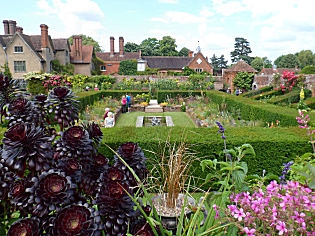

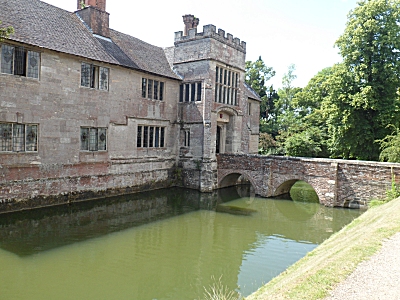
The formal garden was a riot of colour with many herbaceous plantings plus a varied selection of unusual succulents I had never seen before. The Kitchen garden has been newly restored and was planted out with every sort of fruit and vegetables as well as flowers for cutting.
We continued on to Baddesley Clinton just a few miles East. This property was only acquired by the Trust in 1980 when Thomas Weaving Ferrers-Walker, the then owner who inherited the property from his parents, handed it over. You can not just hand a property over to the trust but have to provide an endowment for it's upkeep which Thomas did not have so he embarked on a 10 year fund raising activity, opening the house to the public and enlisting help from local communities. Thomas Ferrers-Walker died in 2006. Unlike many of the old houses we visit this is one I could live in. It is a pure delight.

It was built during the 13th century and from 1517 to 1940 was owned by the Ferrers family. Henry Ferrers (1549-1633) was known as "The Antiquary" because of his love of history and he was responsible for the many additions to the property. He began the tradition of installing stained glass windows depicting the family coat of arms with each generation and the Trust continued that tradition with another stained glass window when they became owners.
In the 1860's Marmion Ferrers inherited the estate and lived there with his artist wife Rebecca and his friend Edward Dering and his wife, the novelist Lady Georgina Chatterton. They were known as 'The Quartet' and spent their time restoring the house and gardens as well as other arty things. Nudge, nudge. Wink, wink! Marmion had no money and it was Edward who provided the funds. When Lady Chatterton and Marmion eventually died, Edward and Rebecca were married. Say no more!
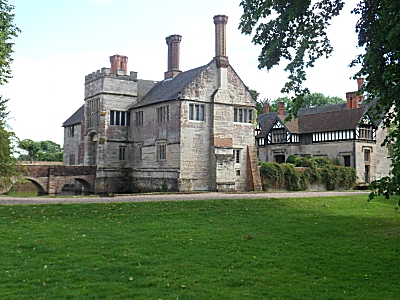
Most of Rebecca's paintings have survived intact and many are on display in addition to those depicting many of the Ferrer family over the generations. They were a Catholic family and the house was used to hide Jesuit priests with several priest holes and hiding places in evidence. Henry Ferrers rented the house for a period to Anne Vaux and she sheltered several Jesuit priests in the house at the time including Henry Garnet who was hung, drawn and quartered in 1606 for his part in the Gunpowder Plot.
The previous owner to the Ferrer family was Nicholas Brome who found his wife in a compromising situation with the village priest and promptly ran him through, killing the poor chap! The bloodstains on the carpet in one of the rooms were said to be the priest's blood but modern analysis showed it to be pigs blood! Nicholas was eventually pardoned by both the King and the Pope.

Regular readers might remember we visited Hartlebury Common Nature Reserve back in the summer of 2013 during our search for somewhere to live. It is one of the few remaining heathlands in Worcestershire and we discovered another one just south of Bewdley.

This reserve is known as The Devils Spittleful and takes it's name from the sandstone rocky outcrop which is surrounded by Scots Pines. A 'spittleful' is a spadeful and a spit is a spades depth so the outcrop is a devil's spadeful and as it is about 50 feet high it would have been a pretty big spade! You might remember that the origins of the Wrekin have a similar legend so it might have been the same giant!
Adjacent to the reserve there are some poppy fields which are also in the care of the Worcestershire Wildlife Trust and the poppies were in full bloom when we visited. The Severn Valley railway runs alongside the reserve as does the West Midlands Safari Park so if you come across the occasional elephant you should not be alarmed!

We wandered around the many footpaths in the reserve and were particularly attracted to the grasses which gave the ground a sort of pink haze. I should imagine that when the heather is in bloom later in the year that it will be even more colourful.
We also walked down to the River Severn to look at the Blackstone cliff on the Severn Way long distance path but it was impossible to get a good view due to high hedges.
We parked in Bewdley and succumbed to a Marshfield Farm honeycomb ice cream before driving back to Bridgnorth.










